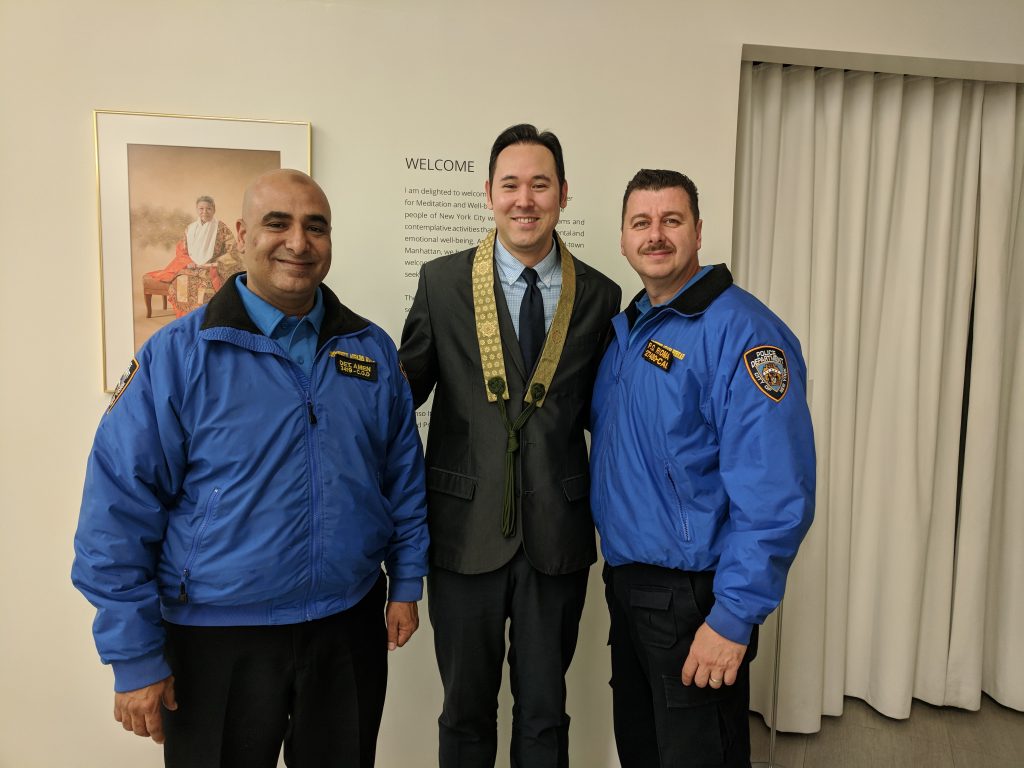Earlier this month, the New York City Police Department became the largest police force in the United States to get on board with the latest trend sweeping law enforcement departments: mindfulness meditation.
Reverend Qalvy Grainzvolt, lead meditation guide at The Shinnyo Center for Meditation and Well-being, is training officers at the New York City Police Academy to offer basic meditation practices to their peers. The meditation block is part of the Crisis Intervention Team training that is required of all of the approximately 36,000 officers on the force.
“[As police officers], they’re going to come across homeless people, criminals, people protesting the political landscape. If they can be in touch with their authenticity, their strength, their empathy, their compassion, to me that can only be a win-win situation,” Grainzvolt told Tricycle when asked about the benefits of meditation in law enforcement.
Police departments across the country have been increasingly turning to meditation to help officers handle stress and increase resiliency in a job that often leads to poor physical and mental health outcomes. Cities such as Madison, Wisconsin, Tempe, Arizona, and Hillsboro, Oregon, already offer meditation training to their officers. After five officers were shot and killed in Dallas in 2016, the Dallas Police Department received a donation that has allowed hundreds of officers to go through a mindfulness and cognitive brain training program called Strategic Memory Advanced Reasoning Training (SMART), the Dallas News reported. And the New York City Department of Correction has been offering meditation to correction officers who work on Rikers Island since 2016.
Related: Meditating with Officers on Rikers Island, New York City’s Notorious Jail Complex
Grainzvolt, who served in the National Guard before joining the Shinnyo-en Buddhist order, traces his interest in wanting to work with police officers back to 2015, when a group of more than 125 Buddhist leaders met with government officials at the White House. Grainzvolt recalled two petitions circulating at that historic meeting: one against nuclear proliferation and the other against police brutality.
“When I read the petition on police brutality, it struck me as a little too polarizing . . . Yes, there are bad apples, but I’m not sure the way to solve a problem is to demonize everyone, and that was sort of the tone of it. So I was really trying to think: What can I do? Should I do nothing? Or can I work from within?”
Grainzvolt thought he could be of service teaching meditation to officers. His first step was going through the Citizens Police Academy, a 10-week course that teaches a condensed version of NYPD training. Grainzvolt graduated at the top of his class in December 2016, and his valedictorian speech caught the ear of then-NYPD Transit Chief Joe Fox.
“When I heard him speak I just got connected to him; I never met him before,” said Fox, who retired in January 2018 after 36 years on the force. “Here’s a man at an NYPD ceremony, with the chief [and other top officials sitting] behind him, who started by saying, ‘I want to let everyone know how beautiful your smiles look now.’”
The chief and the priest exchanged information, and Grainzvolt soon began offering meditation workshops to Transit Bureau officers and civilian personnel. During these sessions, Grainzvolt said he tried to “dispel the myth” that meditation can only be done in a quiet space, and taught that the hustle and bustle of New York City can be used to “cultivate compassion, mindfulness, and sensitivity to others.”
Grainzvolt said it was also important to him that the meditation instruction given wasn’t just about stress management—“do this so you can do that better”—and instead provides officers with the tools to enhance their own awareness.
Fox said he never would have thought to offer meditation training to his staff had he not met Grainzvolt, and said the workshops were one of the “best things to happen in the Transit Bureau.”
“Our brains are in many ways wired to protect us from threat . . . velcro for bad thoughts, teflon for good thoughts,” Fox said, recalling a recent meditation instruction he heard. “In policing, we need to be cautious, aware, and safe, but we also need to be able to turn that switch off.”
Related: Mindfulness in Prison and Beyond
Grainzvolt’s experience leading the Transit Bureau staff in meditation, coupled with another connection—a Shinnyo Center practitioner and social worker who teaches deescalation techniques to NYPD trainees—led to a year-long vetting process for the Police Academy gig. Grainzvolt officially started offering meditation at the Police Academy in College Point, Queens, at the end of January.
“It is really beautiful to see the unique and authentic ways that each officer is making a connection with a practice that I hold dear. We can all share our perspectives while holding the common goal of promoting both inner peace and the peace of the greater community,” Grainzvolt said. “I am really pleased with the receptivity and grounded questions coming from the group of officers I’m teaching.”
Thank you for subscribing to Tricycle! As a nonprofit, we depend on readers like you to keep Buddhist teachings and practices widely available.
